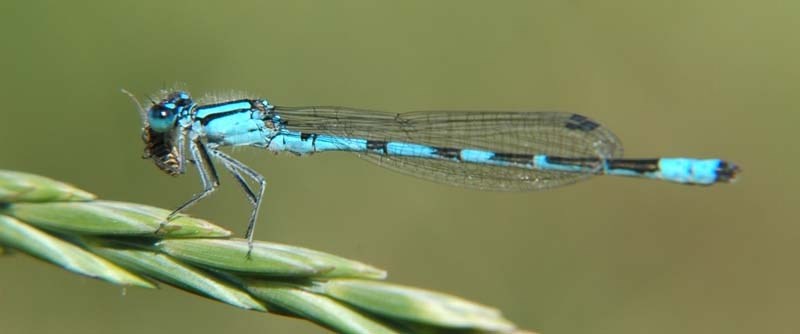If you ever want to see some of the flashiest bugs in St. Albert, simply go to the edge of your local pond and look at your feet. You'll undoubtedly see a small swarm of what naturalist John Acorn calls flying neon toothpicks in the grass – damselflies.
Damselflies are small, thin, brightly coloured winged insects commonly found around ponds and grass.
There's currently about a zillion of them down by the Big Lake Environment Support Society's Summer Nature Centre, says centre co-ordinator Bettina Breau. “It's really good that there are lots of damselflies here lately,” she says, as that's a sign of a healthy ecosystem.
Peter Heule, who runs the Bug Room at the Royal Alberta Museum, says this summer's bumper crop of mosquitoes, dragonflies and damselflies is likely due to all the rain we've been getting.
“They really are quite dainty,” he says of damselflies, and are thinner, smaller and more delicate than dragonflies. “Toothpick is a very good way to describe them.”
You might mistake a damselfly for an ant-lion, Heule notes, which has dull colours and long antennae instead of the damselfly's neon colours and short antennae.
Damselflies can also be mistaken for dragonflies, particularly in their larval form. Damselfly larvae look like wingless adults, and have three fan-like gills that they wave about like tails in the water. Dragonfly larvae are bigger, wingless, and tailless.
As adults, you can tell dragonflies and damselflies apart by their size – dragons are bigger than damsels – and wings. Dragonflies hold their wings perpendicular to their bodies like an airplane, while damselflies will fold them parallel or at a 45-degree angle to their bodies.
They also sound different in flight, Breau adds. Whereas a dragonfly's wings crackle and buzz, a damselfly's are virtually silent.
There are about 22 known species of damselfly in Alberta, Acorn reports in The Damselflies of Alberta, and about 2,570 worldwide.
Around St. Albert you're most likely to see bluets, which are known for their electric blue and black colouration, Breau says. There are many types of bluet, most of which are tough to distinguish without a guide and a magnifying glass.
Also common are spreadwings. Unlike the bluets, which commonly lie parallel to whatever surface they're on, spreadwings like to perch on the side of stems and hold their bodies at an angle to them.
You'll usually find damselflies flitting around reeds and grass, using their giant compound eyes to spot prey and snatch it off branches or in mid-flight with their long, hairy legs. Like dragonflies, they can move each of their two or four wings independently, Heule says, giving them supreme manoeuvrability.
You may also see them pair up for breeding this summer, Heule continues, if they haven't done so already. Like dragonflies, damselflies mate when the male grasps the female by the base of the head using long grabbers on his tail. The female then bends her tail forward between her legs to get the sperm on the base of the male's body, creating a wheel or heart shape.
It's pretty easy to watch a damselfly up close, especially if they're sunning themselves on a leaf or branch – they're not as skittish as dragonflies, I find.
Catching one is not recommended unless you have a net.
“You can damage their wings very easily,” Breau notes – they're like onion paper – so if you try and grab them in your hand, you'll crush or maim them.”
And if you can't find any, Heule says, sit near a pond and let them find you.
“You attract insects … which is something they're attracted to, so there's a good chance that before long, you may very well have a damselfly and dragonfly entourage that's making do on the mosquitoes you're attracting.”
Damselfly
Name:<br />There are many subfamilies, but the order name is Odonata; includes jewelwings, spreadwings, and pond damsels/bluets.<br /><br />Appearance:<br />Thin, hammer-shaped winged insect smaller than your pinky finger, often blue and black, with big eyes and small antennae.<br /><br />Commonly seen:<br />Hovering around ponds or grass, eating bugs.<br /><br />Occasionally confused with:<br />Dragonflies, which are way bigger, and ant-lions which have longer antennae.<br /><br />Fun fact:<br />They occasionally clap their wings together when at rest – no one's quite sure why.
Wild St. Albert
Like wildlife? So do we! Every second Wednesday the Gazette profiles a reasonably common wild creature in the St. Albert region. Birds, beasts, bugs, fish … so long as it's alive and kicking, we'll feature it. <br /><br />Got a creature you'd like to see profiled? Send your suggestions to [email protected].




